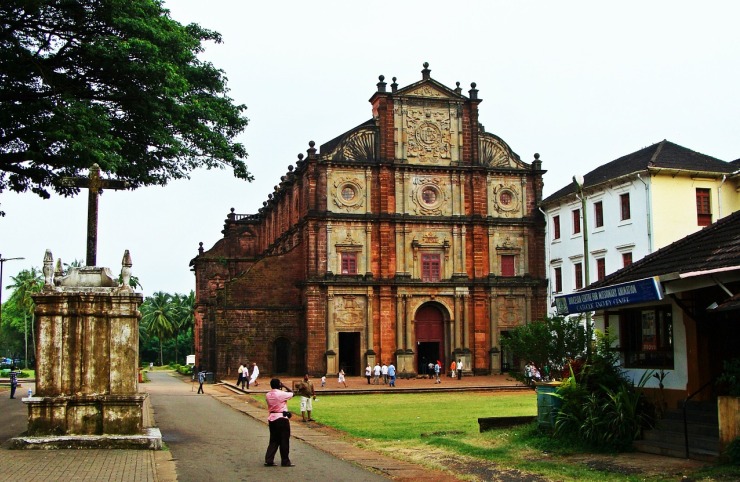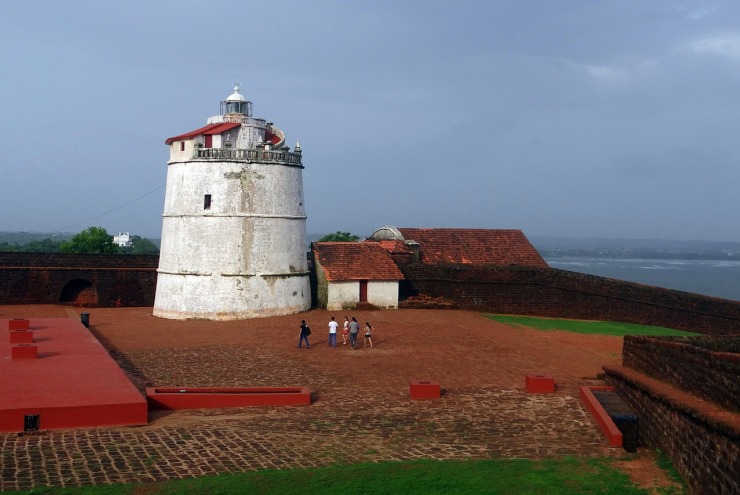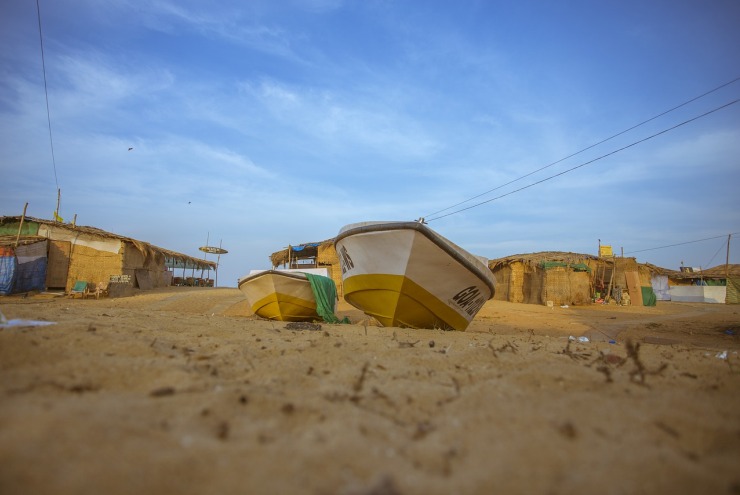Goa – A gilded paradise
Golden, Groovy, Gumptious – Goa. A cocktail of tropical influences. An oasis of white-gold sands, azure waters, and kaleidoscopic skies. A playground for historians, hippies, and spiritualists alike. A backpacker’s haven, and a wealthy man’s fancy. An assemblage of little Portuguese bungalows, and a string of luxury hotels - Goa is a heady blend of the old and the new. If not for every reason mentioned above, make a trip solely for its succulent cuisine.
| Goa: A Quick View of the state |
| Capital |
Panajim |
| Official Language |
Konkani |
| Dial Code |
0832 |
| Population |
3.34952 million (as of 2018) |
| Currency |
Indian Rupee (INR) |
| Time Zone |
UTC+05:30 (IST) |
| Area |
3702 square km |
Highlights of Goa Tourism: Glide through the sands!
Churches in Goa

The Basilica of Bom Jesus is the finest example of Baroque architecture in India. Located in Old Goa,
this exquisite structure holds the mortal remains of St. Francis Xavier. He is preserved in a silver casket and is believed to exude healing powers. The church of Our lady of Immaculate Conception gleams like a tiered wedding cake with pearly white frost. Portuguese sailors would visit this church, as their first port of call, giving thanks for a safe journey. The Se Cathedral, a combination of Tuscan and Corinthian architecture, was built to commemorate the victory of Portuguese general - Afonso de Albuquerque. Amongst its precious ornaments, is a large golden bell that is supposed to be one of the world’s greatest.
Forts in Goa

A quick ferry from Querim will lead you to Fort Tiracol. Originally built by Maharaja Khem Sawant Bhonsle, this imposing fort later became a part of the Portuguese maritime defence. Overlooking the Arabian sea, it offers a picturesque view of turquoise and steel grey. Fort Aguada, with its imposing façade, was built in the 17th century as a defence mechanism against the Dutch and the Marathas. Visit Candolim beach and be transported back to an ancient period of warfare.
Beaches in Goa

Morjim beach or ‘Little Russia’ is the perfect nook for a good book, long walk and uninterrupted serenity. Watch your feet as they sink into pockets of ivory warmth. Enclosed by a dense forest of emerald green, is delightful Palolem beach. Boxes of colourful shacks line the mile-long stretch. Anjuna beach, with its flea markets and expressive-bold hippie culture will awaken your bohemian spirit. Arambol beach, a traditional fishermen’s paradise, is equally mesmerizing. Whether you choose to tread, splash, sail or glide, each one of these beaches will provide you with everything and more. And the cold beer, is just the icing on the cake.
Festivals of Goa
Cashew stomping, coconut braking, and sipping delicious fenny cocktails are some of the many exciting things to do at Goa Cashew & Coconut Festival. If you’re craving some good old carnival magic, then Goa Carnival is the place to be! Watch King Momo sail on a grand float, at the helm of an electrifying parade. Goa Food and Cultural Festival celebrates cuisines from around the globe. Taste some of the delicious goodies, while you enjoy cook offs and dance performances. And if you’re looking to immerse yourself in the cool hippie culture, head to Goa Sunsplash - a reggae festival.
Local culture of Goa
Goa is a sweet synthesis of eastern and western influences. From its quirky paintings, to its local handicrafts, traditional performance arts, and classic Konkani cinema - there is a little something for everybody’s taste. The state is synonymous with its flea markets, strong alcoholic beverages, and of course it’s flavoursome cuisine. Goan cuisine is renowned for its variety of sea food dishes, cooked with an assortment of spices, including coconut, coconut oil, kokum and chilly peppers. Catholic Goan food differs from Hindu Goan food, both equally delicious though. We recommend some of these finger licking preparations – Pork sorpotel, Goa sausage curry, Sannas (rice cake), Bebinca (sweet) and Ros omelette.
Interesting facts about Goa: Riveting revelations
- St Paul’s college, in Goa, is home to Asia’s first printing press.
- India’s first medical school was built in Panaji, in 1842. In 2004, however, it was demolished.
- Goa houses the only Naval Aviation Museum present in Asia.
- Caravela, in Panaji, is the only floating Casino in Asia.
- After Odisha, Goa is the only other state in India to host Olive Ridley turtles.
- Goa has approximately 7,000 licensed bars.
Location of Goa
Situated in the western coast of India, within the Konkan region, is the state of Goa. Goa shares its border with Maharashtra in the north, and Karnataka in the east and south. The latter is separated from the state, by the Western Ghats. The Arabian sea hugs its west coast.
Click here to view Goa on Google Map
Best time to Visit
Goa is a coastal state, hence graced with 40-degree summers and sky-high humidity levels. Although its monsoons paint the state with magical showers, it is not a conducive time to visit the beaches. As such, the best time to visit Goa would be in the winters. November to March makes for the perfect trip, as Goa is blessed with cool breezes.
How to Reach Goa
By Road
A road trip to Goa is never a bad idea, should you choose to drive down or hire a private vehicle or taxi. You also have a wide selection of bus services that offer intra-city and inter-city conveyance. Government operated services include – KSRTC, MSRTC and KTC, while private services include – Neeta Tour and Travels, Paulo Travels and Naik Tours and Travels.
By Rail
Madgaon, Thivim and Vasco da Gama are well connected by rail to other parts of the country. Choose from the following, depending on your point of origin - The daily Goa Express, Mandovi Express, Konkan Kanya Express, Trivandrum Rajdhani, and Goa Sampark Kranti.
By Air
Dabolim Airport is a mere 29 km from Panjim. It has direct flights to and from all the major cities in India, including – Mumbai, New Delhi, Bangalore, Chennai, Cochin and Hyderabad. As an international airport, it has connections to Europe and the UAE.
History of Goa
Memoirs of a state
Rock engravings discovered by archaeologists point towards the existence of prehistoric human life in Goa. Evidence indicates that it was the Acheulean occupation and the Palaeolithic period, that flourished. Early history witnessed the battle and settlements of the following powerful clans – Mauryan Empire, Bhojas, Chutus, Satavahanas, Kshatrapas, Abhiras, Chalukyas, Rashtrakutas, Silharas, Kadambas, Delhi Sultanate, Vijayanagaras, Bahmani sultans, and Adil Shahis. This was followed by the Portuguese rule, which lasted for four and a half centuries. Post-independence, the Indian government requested Portugal to relinquish rights to all the Portuguese territories in the Indian continent. In 1961, through Operation Vijay, Goa and Daman and Diu islands were incorporated into the Indian Union. On the 30th of May 1987, Goa was declared India’s 25th state.
Goa’s history provides you with a backstory. Let these stories color your experiences, and help you connect with the local people, as you travel through the state.


























